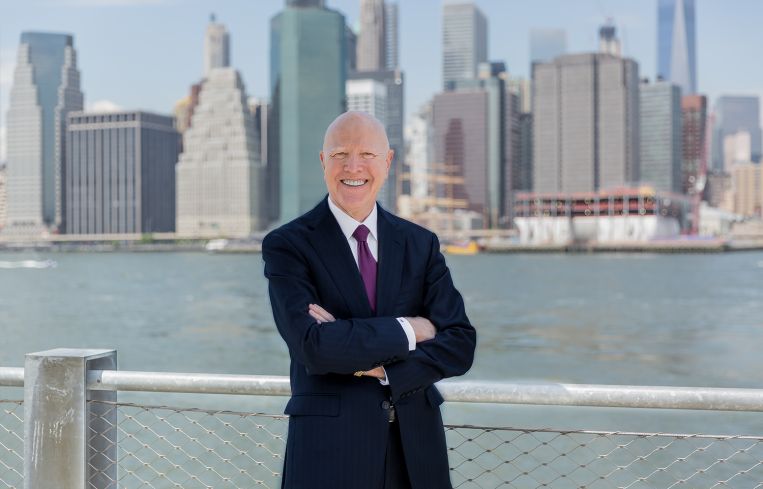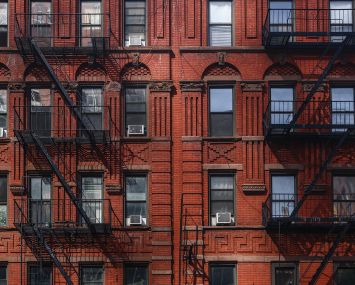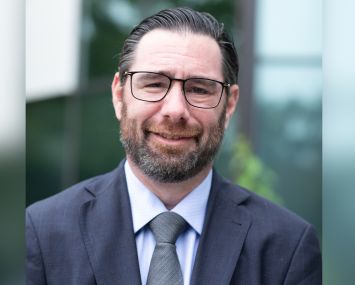A-OZK: George Gleason’s Bank Is Well-Positioned to Weather a Downturn
CO caught up with Bank OZK CEO George Gleason to learn how market lessons have positioned the bank for the COVID-19 market fallout.
By Cathy Cunningham May 4, 2020 11:09 am
reprints
In 1979, a 25-year old banking lawyer named George Gleason acquired an Arkansas bank for $3.6 million. That bank’s name was Bank of Ozark and it had $28 million of assets. Flash forward 41 years, and Gleason is still at the helm, but he’s turned the Little Rock bank into the little bank that rocked, now having amassed $24.6 billion in assets.
In real estate circles, Bank OZK has become widely known as the pre-eminent construction lender. Over the years, its footprint has become larger, its loans have gotten bigger and its borrower profile has become stronger, with the bank lending to top-tier sponsors from coast to coast — something that has put its loan portfolio in good standing as the nation experiences the unprecedented turbulence of COVID-19.
At the same time, its critics — who say it’s too heavily weighted in construction lending, with 35 percent of its loan book dedicated to development debt — have gotten louder. And yet, Bank OZK is the most well-capitalized bank of the U.S.’s top 100 banks (by asset size) today and has posted a profit every year for more than four decades.
There’s no denying that there will be economic fallout on the debt side due to the pandemic. On its end, Bank OZK upped its provisions for loan losses by $117.7 million in the first quarter — compared with a $4.9 million increase in the prior quarter — bringing its loss allowance to $316.4 million, in light of the pandemic and broader regulatory changes.
CO caught up with Gleason, currently in Arkansas, to learn how the market lessons he’s learned over the past 41 years have positioned Bank OZK for the fallout from COVID-19.
Commercial Observer: First of all, these are very unprecedented times we’re experiencing. So, how are you doing?
George Gleason: We’re hanging in here and working hard. There have been a lot of variations and adjustments made, but I’m feeling good.
I just learned that Bank OZK is the number one most-capitalized bank among the U.S.’s top 100 banks, with a Tier 1 Leverage Capital Ratio of 15.36 percent. Is this something you actively worked to improve on over the years?
We’re in a great position as a bank, and we’re very pleased. It’s a great time — in an economy like this — to be the best-capitalized bank out of the 100 top banks. We put ourselves in a position to have the capital that we have today because we need it in order to serve our customers. We do business with a lot of the top real estate developers in the U.S. so we need substantial capital capacity to serve our customers. We’ve been very fortunate to be very profitable, so 20 percent to 30 percent of our earnings typically are dividends and we’ve been able to retain 70 percent to 80 percent of our earnings over the years to accumulate a very strong capital position.
Everyone in the real estate industry knew a downturn was coming at some point, but nobody expected a global pandemic to be the impetus behind it. Were you, as a bank, prepared for a black swan event such as COVID-19?
We had a very detailed pandemic plan, but it had always been a very theoretical plan that was subject to various tabletop exercises to test the implementation of it. What you can’t capture in a theoretical plan like that is the human element of it. When people are dying, when your customers are unnerved and sequestered at home, when your team members are fearful yet interacting with customers … those human factors are hard to incorporate in a tabletop exercise. I’m so incredibly proud of our staff; they’ve not only continued to perform business as usual but they’ve taken this very challenging environment and stepped up and accelerated the implementation of things that were on the drawing board that are helpful in this environment, for example improving our online global banking functionality. We’re opening more accounts now than we were two months ago, which is pretty amazing.
I certainly think we’ll evolve and have a better pandemic plan than we had this time around because you’re not going to have the same level of detail unless the plan you prepare is something you’ve actually lived through.
Has this pandemic changed how you’ll be stress testing your loan portfolio going forward?
Our stress testing probably won’t change a lot; we did seven stress tests last year, and the most adverse stress tests are probably not too different in the aggregate results to where we find ourselves today. So stress testing is certainly a very useful exercise. You’re right when you said that none of us anticipated a pandemic. I was asked several times over the past two years “What will cause the next recession?” and I’d say “It’s not going to start in real estate, it’s not going to be subprime housing, it’s not going to be any of the things that caused the last recession. It’ll be something none of us have on our radars.” Now, if I’d been making a list of 100 things that it could be, a pandemic would probably not be on that list. But sure enough, it was something that none of us foresaw and here we are.
When it comes to your real estate loan portfolio, how has your approach to underwriting evolved since the global financial crisis?
It’s really changed significantly. As of March 31, the end of the last quarter, if every loan was fully funded in our RESG [real estate specialties group] we would have been at 50.4 percent weighted average loan-to-cost and a 41.5 percent weighted average loan-to-appraised-value. Going into the great recession, we would have had LTVs in the 60s, say 68 percent LTV plus or minus was our typical loan to value and a 71 or 72 percent loan-to-cost basis. So we are roughly 22 to 26 percentage points below that now. As we went through the great recession — and we posted record earnings each year through the great recession, by the way, we’re very proud of that — we also suffered some pretty good credit hits on loans. We looked at that and realized pretty quickly that the loans we had the most problems with suffered the biggest losses on were the loans that were high loan-to-value. So we acted quickly to get our loan-to-value and loan-to-cost down on these loans. Over the ensuing decade, we lowered them 25 points, plus or minus, over that period. That’s huge in protecting us from loss. We’re also a much larger bank than we were a decade ago and we’re able to deal with many more top-tier sponsors who have very strong balance sheets, well-diversified portfolios and just greater level of experience and ability than some of the sponsors we had in the last downturn and a decade ago. Now, we still do business with a lot of people we did business with back then but we’ve added a whole another layer of top-of-the-line real estate sponsors to our portfolio of clients.
Unlike some of its competitors, OZK doesn’t sell loans down or syndicate debt, but rather holds its loans on its books. What have you learned about the health of your current real estate loan portfolio in the wake of this crisis?
We’re feeling very good about our portfolio. Our net charge-off ratio in the first quarter this year was 10 basis points on total loans and 8 basis points on non-purchased loans — those are loans we originated — and that’s an annualized ratio. Those are just among the very best in the industry, so we continue to feel very good about our portfolio. Certainly, hotels have been hit very hard by the pandemic and will take a while to recover. But our hotel loan portfolio is like the rest of our portfolio in that it’s low loan-to-cost and loan-to-value; I believe it’s 52 percent loan to cost and 40 percent loan-to-appraised-value. We have experienced, sophisticated sponsors, for the most part, they’ve been in the hotel business and owned properties through 9/11, through hurricanes, floods and other natural disasters and various economic downturns. They know that in a downturn you have to continue to invest money in your asset and protect your equity. Given that our sponsors have such huge investments in these properties, and are such capable sponsors, we expect to have relatively few problems because of the quality of the sponsors and the depth of the equity invested.
That’s also something that’s a big change compared with the global financial crisis — the amount of equity in deals.
I agree with you, it’s a significant change. The second thing is there’s far less speculation in development. Going into 2008, 2009, 2010 there was so much speculative development of property that when you had a downtick in demand and the speculation came to an end there was so much inventory to unwind and unload. That’s not prevalent around the country today. You have certain areas where you have an oversupply of a particular product but it’s not to the same extent it was going into the global recession.
What are you hearing from your construction loan borrowers? Given that construction has come to a standstill in most major markets, are they keeping their cool or starting to panic?
I’m not seeing many, if any, panic. Everyone is frustrated by having to shut down a project but everyone understands it. My view is that most of our sponsors are accustomed to some sort of issue or disruption in projects. You’re in New York, and it’s not uncommon to have a stop-work order on a project because it generates too much noise, or too much dust or a party wall is cracked on an adjoining building. There are all sorts of things that cause projects to be stalled, and this is a widespread stalling but most sponsors are accustomed to that. The projects will get going again in a couple of months and the budgets for these projects typically have enough contingencies and reserves in them that a few months will not derail them.
Does the bank’s healthy position prove the critics wrong who have said it’s too heavily weighted in real estate construction lending? Some say this has had an effect in holding your stock price down. What do you say to these critics?
We do have a very strong capital position and a lot of expertise and a very positive and demonstrated track record in doing what we do. We are a construction lender and we do that all the time; in recession and in boom times. We’re always in the business. When you’re going to do something all the time as opposed to when it’s trendy and hot, you’ve got to be disciplined about the way you do it and you’ve got to develop some expertise. Our stock tends to benefit when construction lending is in vogue and construction lending seems like an exciting thing to do. It tends to get pressed when people think, “Oh construction lending may be dangerous or commercial real estate may not be the best asset to be invested in,” but the truth is we do this all the time. Our track record of being profitable every year under my leadership for 41 years speaks for itself and we’ll continue to do it because it’s what we do. It’s our business. The more time that passes and the more cycles we go through, people will begin to understand that we’re different. We’re in this business all the time, we really do have unusual expertise and we’re very conservative with low loan-to-value and loan-to-cost ratios. I think we’ll get more credit as time goes by.
Lending consistently through good times and bad must also deepen your borrower relationships.
It’s a very important part of our business. I’ve been doing this 41 years and when I got into this we were only at $28 million in total assets — a tiny fraction of our current size — and yet we still do business today with many of the people I started doing business with back then. We have a fabulous team of bankers that really run this company and it’s my privilege to get to lead that team. But they share my view that this is a relationship business and it’s important that we be there for our customers. You can’t be there for customers if you’re only lending six out of every 10 years. You’ve got to be in the business consistently and help our customers in good and bad times.
You mentioned on your earnings calls that you’re looking at some market opportunities as a result of the pandemic fallout. Can you tell me what some of those opportunities are?
In recent years a lot of lenders have gotten into commercial real estate and you’re already seeing some of those lenders pull back. I think that creates additional opportunities for us. We’ve had an influx of new competitors in our business, and that cut into our volumes and cut into our margins. I think we’ll see some of that normalize as some of the more trendy entrants into the space decide that it’s not going to be as much fun as they thought it was going to be.
Are you primarily focused on your current loan portfolio today or are you also considering new lending opportunities?
We always keep an eye on the ball we have in our hands, and that’s our existing portfolio. That said, we had one of our best origination quarters in years in the first quarter and we have a great pipeline going into the second quarter so we’re cautiously optimistic about our ability to grow our book this year. It remains to be seen what kind of demand there is in the future quarters of the year depending on the economy and the pandemic, but we’re actively looking at new opportunities in all the markets we do business in on a regular basis. One thing I’m proud of is that during the Great Recession there wasn’t one single day that we didn’t have the ability to review loan applications on any property type or market we were doing business in. We’re in that same boat today and we’re open for business. We’re looking for new opportunities with quality sponsors on projects that make sense and I think that will always be the case for Bank OZK.
How are you preparing for a potential second, potentially more aggressive, wave of the virus this fall?
As far as it pertains to our staff and our customers, we’re actually sitting down next week to develop a ‘return to work’ plan and its critical elements will include limitations on human interaction and reducing activities that can spread a cold or a flu or a coronavirus or anything else. So, health considerations will be paramount going forward. I believe that if companies do a good job in preparing for business activities and individuals do their part too, we may avoid a second outbreak. But it’s incumbent upon businesses and government entities at all levels to do their part to determine the appropriate ways to re-engage normalization of practices. We’ve got active businesses in well over 80 percent of the states. What works in Arkansas and what works in New York will be very different because of the density of population and things like individual transportation versus mass transportation. So it’s not a one-size-fits-all solution. We’ve got offices in New York, L.A., San Francisco, Atlanta and then dozens of smaller markets throughout the south. One of those markets will not be a direct approach for others, so we have to work all that out but we’re going to very carefully plan that process, in a systematic way that doesn’t unnecessarily expose our team members and our customers to risk. There’s definitely going to be a lot of hand sanitizer, Lysol and face masks in that plan.
You acquired the bank in 1979 for $3.6 million when you were just 25 years old. You’ve seen a few crises over the years, so what are the lessons you’ve taken from them that are proving useful in this current crisis?
We learn from every period of economic change, whether it’s good or bad, and one of the things we’ve tried to do during my 41-year career is always learning from the mistakes we’ve made. When I got into the business Paul Volcker was chairman of the Federal Reserve and within a year of me getting in the business, the prime lending rate was 21 percent. We learned from that environment, from the real estate crisis, from the agricultural crisis, the oil crisis — there have been a lot of events in my 41-year career! We’ve learned from each of them, and they’ve become ingrained in our thought process. By having learned from prior experiences and not forgotten the lessons we learned — because I think a lot of bankers learn from them but after a decade goes by they forget them again — we don’t have to learn from them again. We’ve been profitable every year in my 41 years; we’ve never lost money. There aren’t a ton of banks that can say that, so we’re proud of that and that’s a credit to the fact that we have really learned from and applied lessons from the past.
Any near-term goals you’re hoping to achieve once we get back to some semblance of normal life?
I’ve been on the phone with a lot of our big New York-area customers and a lot of them have said, “as soon as you’re traveling again we want to have breakfast with you or dinner with you in New York.” So, I expect to be in New York quite a bit over the next few months … and eat really well there!


